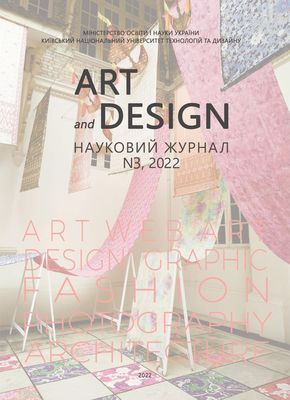DEVELOPMENT OF AN ADVERTISING POSTER AS A CURRENT MEANS OF ADAPTIVE VISUALIZATION OF SOCIAL PROBLEMS
DOI:
https://doi.org/10.30857/2617-0272.2022.3.10Abstract
Purpose: research of graphic representation of advertising images, as well as psychological methods of influence and verbal means of expression of the poster in order to determine the effectiveness of social advertising. The relationship between creativity and innovation in the design of social advertising is analyzed.
Methodology. The theoretical and methodological basis is defined as a systematic approach in the study of the poster genre of world and domestic graphic artists. System-structural and associative methods were also used in the study of artistic compositional features and semantic resource in the historical development of the poster as a special artistic genre. Historical-typological, retrospective, analytical methods, as well as figurative-stylistic and comparative analysis methods were used to conduct the research.
Results. The task of the communicative component in the creation of a poster, its graphic saturation, and their combinations to increase the possibilities of differentiated influence during active use in society is considered. It is noted that the task of social advertising, including the identification of acute social problems, is the proposal of solutions to the impossibility or elimination of threats to society with the help of a specific model of behavior. Visualization of the effect of combining several color codes and the use of fonts successfully used by designers, copywriters, and advertisers is highlighted. It was found that social advertising uses a large number of ways, methods, methods of social and psychological influence and manipulation in propaganda. It is established that advertising should be considered as a symbolically organized space where the designer must manipulate the provided cultural meanings given in verbal or non-verbal form – the key non-verbal component is the image that confirms the authenticity of the slogan. The created images emotionally enrich the way, give a clear impression of the presence of the viewer in the depicted situation, and give the situation realism. It has been proven that the specificity of the poster as a short-lived advertising object requires its relevance, sharpness and semantic tension, even in cases of visualization of eternal problems of humanity.
Scientific novelty of the work consists in the structuring of the features of the basic principles of the expressive language of the social poster, the knowledge and mastery of which will allow the designer to create a competent and effective modern product. The formal principles of graphic presentation of information were studied and identified, the principle of unequivocal treatment and interpretation of the social message, as well as the principles of synchronicity, capacity and brevity, semantic integrity were found to be the most important. It has been proven that expressive visual means are used in social advertising as the main means for strengthening communication and concentration of the addressee's attention. It is noted that in modern advertising, graphic designers focus on the conscious and unconscious effects of advertising on the consumer, studying the peculiarities of the emergence of rational (based on logical arguments) and irrational effects, which are based on emotions and feelings.
Practical significance. Thematic social advertising of family, childhood, and parenthood was determined as the subject of research with the aim of creating a series of poster design products. It was found that in order to create effective advertising, a graphic artist must work through imagery and metaphor; the use of humor as a psychological element of confronting fear; appeal to human values and their positive models; use of various types of communications, including unexpected and non-standard ones; creation of logical, instructive messages, slogans. The author's concept was proposed, an idea was created and a series of social posters were developed, similar in visual components and semantic load, the main one of which is the dream of children from an orphanage to have their own family. Techniques and materials, as well as software for implementing the concept, are offered; suggestions for printing features are provided.

